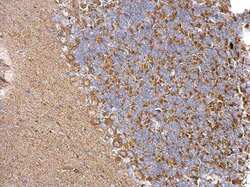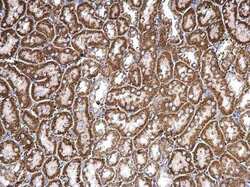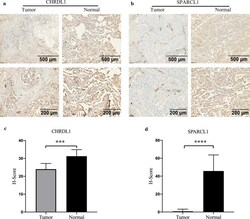Antibody data
- Antibody Data
- Antigen structure
- References [1]
- Comments [0]
- Validations
- Immunohistochemistry [2]
- Other assay [1]
Submit
Validation data
Reference
Comment
Report error
- Product number
- PA5-78591 - Provider product page

- Provider
- Invitrogen Antibodies
- Product name
- CHRDL1 Polyclonal Antibody
- Antibody type
- Polyclonal
- Antigen
- Recombinant full-length protein
- Description
- Positive Control: rat brain Predicted Reactivity: Human (100%), Chicken (82%), Rhesus Monkey (100%) Store product as a concentrated solution. Centrifuge briefly prior to opening the vial.
- Reactivity
- Human, Mouse
- Host
- Rabbit
- Isotype
- IgG
- Vial size
- 100 μL
- Concentration
- 1.52 mg/mL
- Storage
- Store at 4°C short term. For long term storage, store at -20°C, avoiding freeze/thaw cycles.
Submitted references Low expression of CHRDL1 and SPARCL1 predicts poor prognosis of lung adenocarcinoma based on comprehensive analysis and immunohistochemical validation.
Deng H, Hang Q, Shen D, Zhang Y, Chen M
Cancer cell international 2021 May 12;21(1):259
Cancer cell international 2021 May 12;21(1):259
No comments: Submit comment
Supportive validation
- Submitted by
- Invitrogen Antibodies (provider)
- Main image

- Experimental details
- CHRDL1 Polyclonal Antibody detects CHRDL1 protein at cytosol on mouse hind brain by immunohistochemical analysis. Sample: Paraffin-embedded mouse hind brain. CHRDL1 Polyclonal Antibody (Product # PA5-78591) dilution: 1:500. Antigen Retrieval: EDTA based buffer, pH 8.0, 15 min.
- Submitted by
- Invitrogen Antibodies (provider)
- Main image

- Experimental details
- CHRDL1 Polyclonal Antibody detects CHRDL1 protein at cytosol on mouse kidney by immunohistochemical analysis. Sample: Paraffin-embedded mouse kidney. CHRDL1 Polyclonal Antibody (Product # PA5-78591) dilution: 1:500. Antigen Retrieval: EDTA based buffer, pH 8.0, 15 min.
Supportive validation
- Submitted by
- Invitrogen Antibodies (provider)
- Main image

- Experimental details
- Fig. 10 The distribution and expression of CHRDL1 and SPARCL1 proteins in twenty pairs of LUAD and normal tissues. Representative pictures of immunohistochemistry of CHRDL1 and SPARCL1 proteins are shown ( a, b ). The score of immunohistochemistry of CHRDL1 and SPARCL1 proteins are displayed ( c, d ). ***P = 0.001; ****P < 0.001
 Explore
Explore Validate
Validate Learn
Learn Western blot
Western blot Immunohistochemistry
Immunohistochemistry